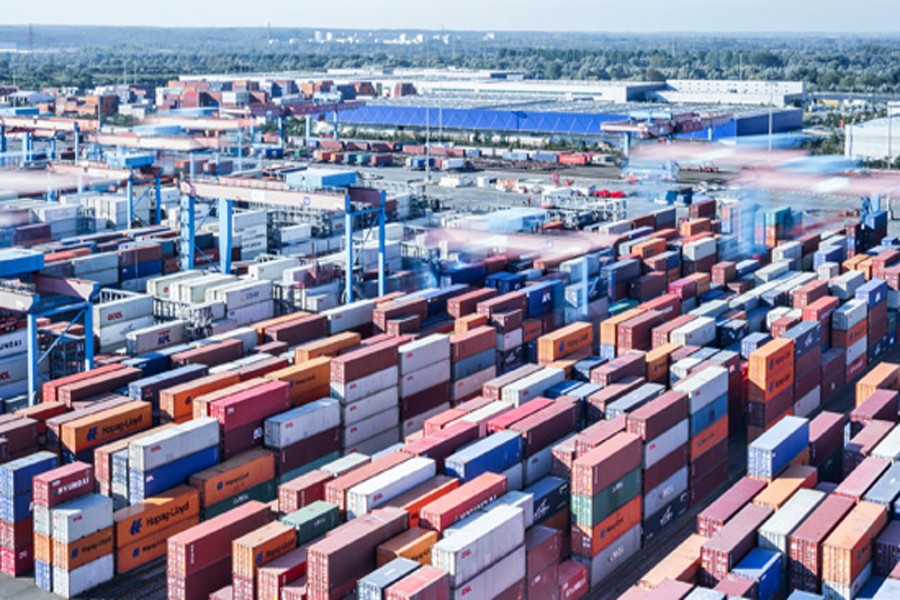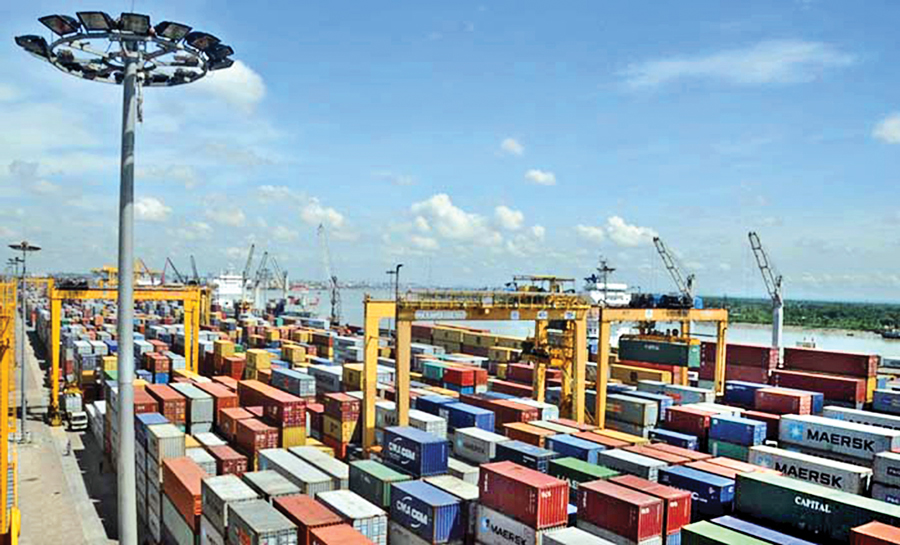
 Chittagong Port has constructed seven jetties in long 45 years since liberation of Bangladesh from the Pakistani junta through a bloody war of nine months in 1971. Prior to independence, the country's prime seaport had 13 jetties. During the last nine years of Sheikh Hasina's government, the national economy made satisfactory progress. At the same time, operational activities at the prime seaport -- Chittagong Port -- increased at an annual average growth rate of 15 to 17 per cent.
Chittagong Port has constructed seven jetties in long 45 years since liberation of Bangladesh from the Pakistani junta through a bloody war of nine months in 1971. Prior to independence, the country's prime seaport had 13 jetties. During the last nine years of Sheikh Hasina's government, the national economy made satisfactory progress. At the same time, operational activities at the prime seaport -- Chittagong Port -- increased at an annual average growth rate of 15 to 17 per cent.
Business leaders say the port authority by this time should have developed port facilities by constructing more jetties and procure lots of cargo-handling equipment to expedite the port growth. Unfortunately, that did not happen. Not a single port terminal has been developed in the last 10 years. The Chittagong Port Authority's activities remained confined to paper work in a decade. Very recently, the Chittagong Port Authority (CPA) inaugurated ground-breaking for construction of the Patenga Container Terminal. A contract has been signed with the Bangladesh Army's Engineering Corps to construct the terminal.
Currently, a total of 12 container ships can berth at a time -- six at the general cargo berths regarded as main jetties of the port, two at the Chittagong Container Terminal and four at the New Mooring Container Terminal. Operations of 13 general cargo berths (GCBs), constructed only for handling the general cargo, have now been divided into 12 berths, which are the main jetties. The port has six berths in the GCB area and one berth at the New Mooring Container Terminal (NMCT) for handling cargoes other than those in containers. The port can now handle nearly 2.5 million TEUs (twenty-foot equivalent unit) of containers annually and has set a target to handle over 3.0 million (30 lakh) TEUs through implementation of its far-reaching projects including construction of the Karnaphuli Container Terminal (KCT) at the existing jetty nos. 9, 10, 11, 12 and 13, the proposed Laldia Multipurpose Terminal and also development of a bulk cargo terminal at the KCT.
Forty-six pieces of equipment including three Rubber-tiered Gantry Cranes (RTGs) were added to the container handling facility in the last fiscal year at the cost of Tk 1.35 billion (Tk 135 crore). In the fiscal year 2017-18 the CPA planned to purchase 251 categories of equipment. The CPA recently signed a deal with a Chinese company to buy six gantry cranes. The deal was signed last month for procurement of six rail-mounted gantry quay cranes at a cost of Tk 3.44 billion (Tk 344 crore) for handling containers smoothly.
The CPA and Shanghai's Zhengdua Heavy Industries Co signed the contract at the Ministry of Shipping in presence of the Shipping Minister and the secretary of the ministry. The Chinese company will deliver the cranes to the CPA within 18 months from the date of signing the contract. It is expected that six gantry cranes will arrive at the port by April or May 2019. The six new cranes will be installed at the New Mooring Container Terminal.
Earlier, the CPA purchased four gantry cranes in 2005 but two of them are now operating. The other two cranes remain out of order after getting damaged by a foreign ship at the Chittagong Container Terminal CCT).
The CPA said more than 90 per cent ships arriving in the port are container ships and the remaining 10 per cent are also expected to be converted to container vessels very soon. Carrying bulk cargoes like sugar, rice and wheat has already been containerised. Therefore, the port needs to improve its efficiency and efficacy both in terms of human resources and technology for handling of containers.
Opening of the NMCT, comprising five berths, has increased the stacking capacity of the port substantially and hence increases the capacity of the port. In addition, new warehouses and sheds are opening and the long-awaited railway extension, work on which has already commenced, will ease the current pressure on the roads and railways and will allow the port to operate at its maximum efficiency.
M Mansur Reaz, programme manager of the World Bank, said at a meeting on Chittagong Port problems organised in Dhaka that despite installation of some equipment, the port's operational quality did not improve. For enhancing the port's efficiency he suggested greater involvement of the private sector in the port management, improvement of the port governance and introduction of a competition in service quality. In the meeting, CPA chairman Rear Admiral M Khaled Iqbal recommended that businesses should increase their use of the Pangaon river port to reduce congestions at the Chittagong Port.
The national trade body leaders in the meeting also stated that efficiency of the port did not improve keeping pace with its cargo handling growth, forcing exporters and importers to incur losses as the container congestion worsened. The exporters are lagging behind their competitors from other countries as the congestion costs time and money. They incur losses as they have to count demurrage for overstay of container vessels at the prime seaport. The businesses said the NMCT built in 2007 cannot run in full swing due to shortage of handling equipment.
The business cost is increasing due to inefficiency of the country's premier port. At present, it takes more than two weeks for release of goods from the port, which was supposed to be delivered within 48 hours. Port experts allege non-cooperation among the service delivery agencies like port authority, Chittagong Customs House, customs clearing and forwarding agents, transport operators and banks are mainly responsible for the delay in the release of goods. They suggest involving the private sector in the management of the port, through which 92 per cent of the country's export and import trade is done.

The cost of the port management's inefficiency has to be borne by businesses ultimately. The country could not achieve its export target for readymade garments (RMG) in the last fiscal year (2016-17) mainly due to longer lead-time at the port. On the other hand, RMG exporters from Cambodia, Sri Lanka and India, who are main competitors of Bangladeshi exporters in the global apparel trade, achieved their export target. Shorter lead-time of ships at their ports and their excellent performance were the main reasons for it.
Because of the delay at the Chittagong Port, the RMG exporters are compelled to use the expensive air shipment of exports to maintain the strict lead time of buyers. Had the Chittagong Port performed at the same level of that at Colombo, the maritime cost might have been far less and the Bangladeshi exporters could have sent goods to the United States at 0.6 cents to 0.8 cents per kilogram (kg). The port users have said that many ships do not want to carry goods from Chittagong Port. Rather, they are interested in transporting goods at very cheap rates from the ports of Malaysia and China.
M Kamal Hayat, an export on port activities and former chairman of Bangladesh Shipping Agents Association, said the CPA is administered under the Chittagong Port Authority Ordinance -- 1976 and the Chittagong Port Authority (Amendment) Act 1995. From the past long experience as a port user he observed that though general directions and management of the authority are vested in the board of the CPA as per the sub-section (2) of the Section 5, the authority of the board has been squeezed. It has been gathered that the board of the CPA cannot function as per power it is entrusted with due to administrative orders and guidelines given by different ministries and authorities from time to time.
Mahfuzul Huq Shah, Port and Shipping Standing Committee Member of the FBCCI and convener of the sub-committee of Port Affairs of Chittagong Chamber of Commerce and Industry, said the Chittagong Port needs to enhance its handling capacity in conformity with the growth in the cargo volume. Infrastructure development of the port is the crying need and construction of the Bay Terminal is the immediate answer to the port problems.
He said authoritative power of the Chittagong Port Management Board needs to be enhanced as it cannot take important decisions on major procurement schemes of the port. In that case the related laws and regulations that guide the port activities need to be revised and updated like other regional port authorities. He said the port is running with infrastructure of 2005. While the demand from the port has increased, it is lagging 10 years behind in terms of construction of jetties, terminals and installation of equipment. If we fail to do these jobs, the entire economy of the country will suffer and the momentum of progress will be lost.
The writer is Chittagong Correspondent of The Financial Express.
© 2024 - All Rights with The Financial Express
